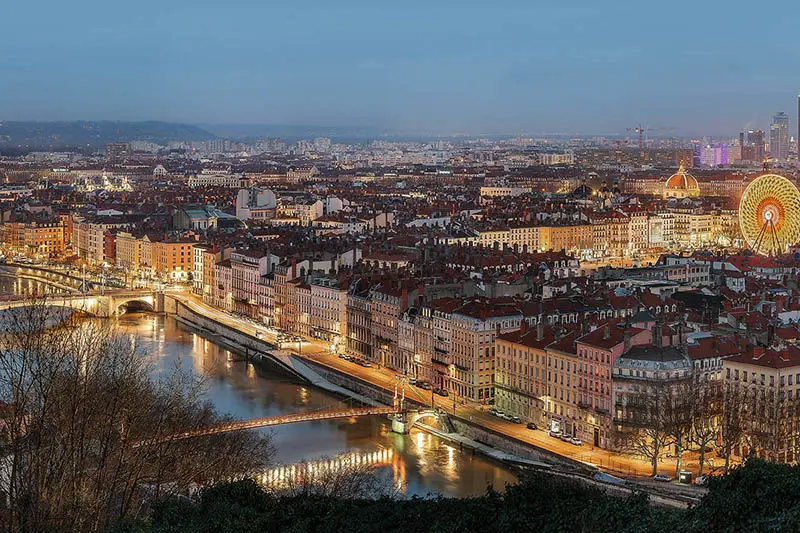
INTRODUCTION
Situated in the Auvergne-Rhone-Alps where the Saona and Rhone rivers meet, the city of Lyon is dominated by two hills: Fourvière to the west and Croix-Rousse to the east. This grand metropolis of more than 500,000 inhabitants is the third most populous city in France after Paris and Marseille.
Listening to this audioguide as you stroll through the historic heart of Lyon is like taking a walk through time, from the city’s founding in 43 B.C. right up until the present day. People settled in this urbanized zone more than two thousand years ago and built a town whose developmental phases are still visible today: from the Roman remains of the old Lugdunum to the medieval alleys of the Fourvière foothills; and from the Renaissance houses of Lyon Old Town to the classical architecture of the peninsula. Then there’s the hills of Croix-Rousse and its characteristic Canut workers housing, an essential part of the history of 19th-century industry and employment.
427 hectares of the city have been classified as World Heritage by UNESCO since 1998, making it one of the largest protected regions along with Bordeaux. Some of the sites covered in this audio guide are the Fourvière hill, Lyon Old Town, the Croix-Rousse Hill, and the Peninsula.
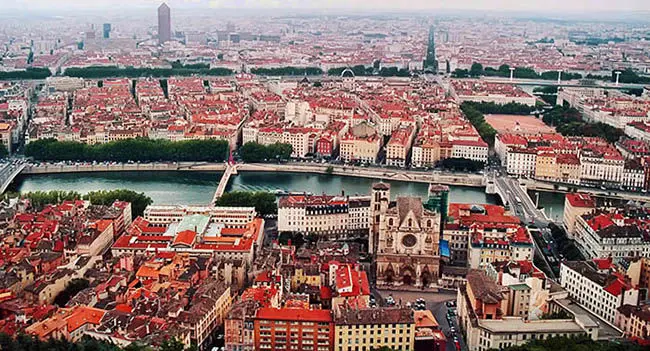
SOME HISTORICAL LANDMARKS
The origins of human settlement in present-day Lyon likely dates back to the year 10,000 B.C in the north along the Saona River in Lyon-Vaise (9th district), where there was once a major port. Later, the population gradually expanded during the Bronze Age and the Iron Age.
In 43 B.C., the Roman governor Munacius Plancus founded a colony at Fourvière called Lugdunum. Around 20 B.C., the city became the starting point of the four major Roman roads that led to the Rhine, the English Channel, Aquitaine, and Narbonne. The city remained prosperous until the middle of the 2nd century and became the economic capital of Gaul. It grew on both sides of the Saona and the Peninsula, obtaining an estimated population of up to 50,000 inhabitants.
In the 3rd century, Lyon suffered severely from Germanic invasions and banditry. The city went into decline, and its inhabitants moved from Fourvière to Saint Paul and Saint George. The new center belonged to the Episcopal religious order of Saint John. Lyon developed further along the Saona in the Middle Ages and became the second largest city of medieval Christianity after Rome.
Lyon’s most prosperous era was undoubtedly in the 16th century. At this time during the Renaissance, the city of some 60,000 inhabitants became an essential hub for European trade. Lyon organized four annual trade fairs that lasted for two weeks each, attracting merchants from all over Europe and strengthening relations with Mediterranean countries, northern France, the Rhineland, and Switzerland. As an international city of strong repute, Lyon became a financial center and hosted branches of the most famous Italian banks, from Florence, Milan, and Lucca.
By the 19th century, Lyon already had a large number of silk weaving factories that stretched from the neighborhood of San George to the Croix-Rousse. Silk weaving was a crucial industry thanks to the city’s proximity to Italy, where most of the material came from. The silk weavers of the time were called Canuts; a derogatory term that comes from the Italian word “canuto,” which refers to someone whose hair has gone grey.
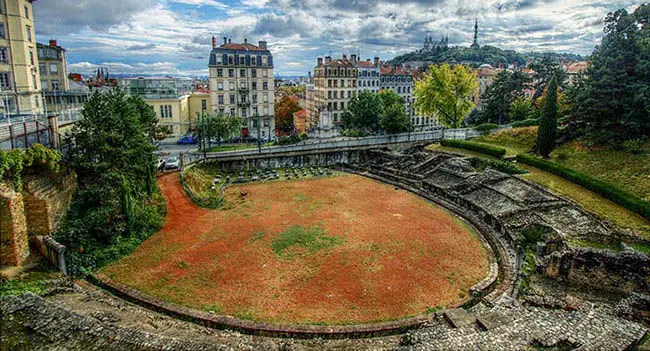
URBAN PLANNING AND ARCHITECTURE IN LYON
An interesting aspect of Lyon is how it has gradually extended eastward, preserving the history of its ancient architecture at each stage of the expansion. Unlike other cities where the center has been destroyed and rebuilt with modern architecture, Lyon has opted to relocate its city center over time, thus preserving entire neighborhoods whose very presence showcases the history of the city and its architecture.
Lyon is full of notable buildings: the 13th century Thomassin House in the Place du Change that was extended in the 15th century; Claude de Bourg’s House of 1516; the house of the poet Maurice Scève of 1493, of which an extra floor was added in the 17th century; The Chamberlain’s Mansion (1495-1516) that illustrates the transition from the Gothic to the French Renaissance era; The 1647 Lyon Mannerist House; The classic Quai Lassagne building of 1760 and the "House of 365 Windows” plus the Cour des Voraces, which are two notable examples of the homes built for the Canuts during the first half of the 19th century.
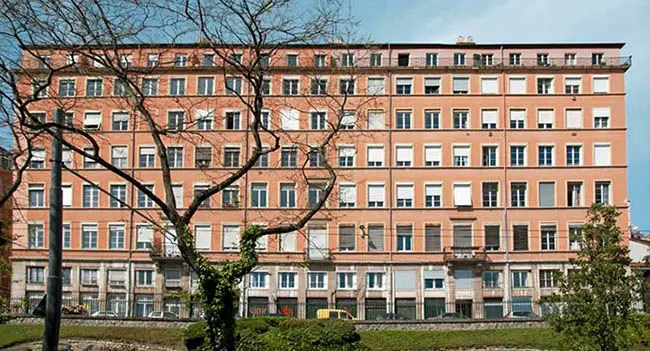
URBAN PLANNING AND ARCHITECTURE IN LYON (PART 2)
Some of the public buildings that are worth mentionning in the audioguide include: The Manecanterie, a clergy singing school of the late 11th century; The 1107 Romanesque Abbey Church of Ainay; The Saint John the Baptist Cathedral, which was built between 1180 and 1480 and retains a remarkable stylistic consistency despite its lengthy construction process; The Saint Nizier Church, of which construction began in the 14th century and finished in the 19th century, and which features a flamboyant Gothic nave plus a Renaissance façade and a neo-gothic spire; The imposing City Hall, which was built from 1646 to 1703; The 17th to 18th-century Hôtel-Dieu; The Loge du Change (1745-1780), which is now a Protestant temple; The Fourvière Basilica (1872-1896), which is among the most emblematic monuments of the city and the House of the Canuts, which was designed by the modernist architect Tony Garnier and built between 1927 and 1933.
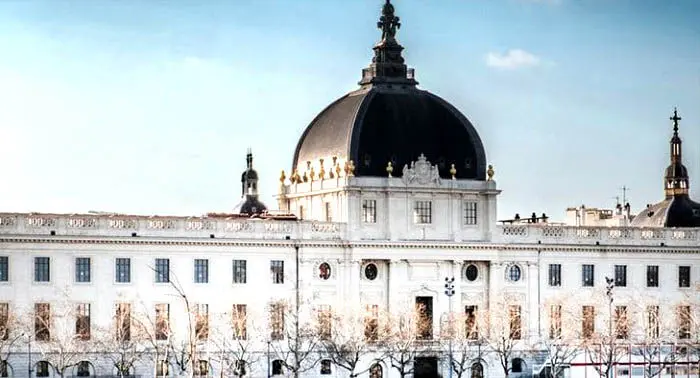
LYON OLD TOWN
Residing at the foot of the Fourvière hill on a 24-hectare zone, Lyon Old Town is one of the largest Renaissance regions in Europe along with Venice. Despite being founded way back in 43 B.C., the district still preserves the vestiges of its rich historical past.
Ever since being declared a World Heritage Site by UNESCO in 1998, the old town of Lyon is the favorite spot among tourists visiting the city. Strolling through its labyrinth of cobblestoned streets, perusing its souvenir stalls, dining at its traditional restaurants, and admiring its medieval and Renaissance architecture is a pleasure to be savored.
The old town has three main neighborhoods that were initially defined by social class and which still retain their own unique identity:
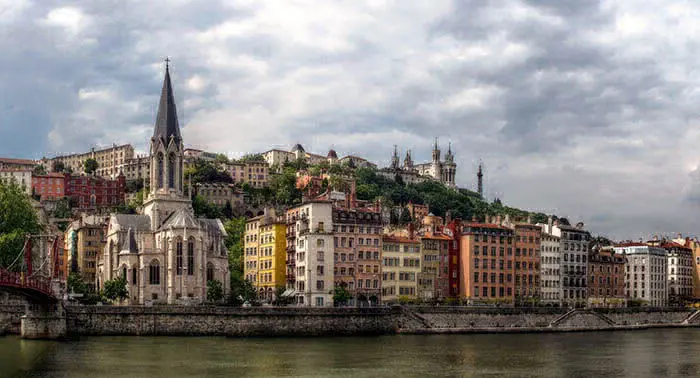
SAINT-PAUL DISTRICT
First is the Saint-Paul quarter in the north, which was the home of the bourgeoisie and the central financial and commercial hub during the Renaissance period. These days, it’s the city’s primary student district and extends around the Saint-Paul Church, which is a remarkable monument and a crucial part of the heritage of Lyon. Built in 549, the church was destroyed by the Saracens and rebuilt again in the 12th century. It’s a jewel of Romanesque design, elegantly showcasing the architectural advances made during these periods in all their splendor.
In this district, you can also find Saint-Paul Station and Saint-Paul Square. Here, you can admire the square turrets and corbels of the house of Laurent Mourguet, where the creator of the famed Guignol puppets once lived. Finally, don’t miss Rue Juiverie, a paved pedestrian street with a distinctly medieval atmosphere. Be sure to check out Philibert de l'Orme gallery, which is situated at number 8 of the Hotel de Bullioud mansion, and has been classified as a historical monument. It was the very first Renaissance-style building to be constructed in France!
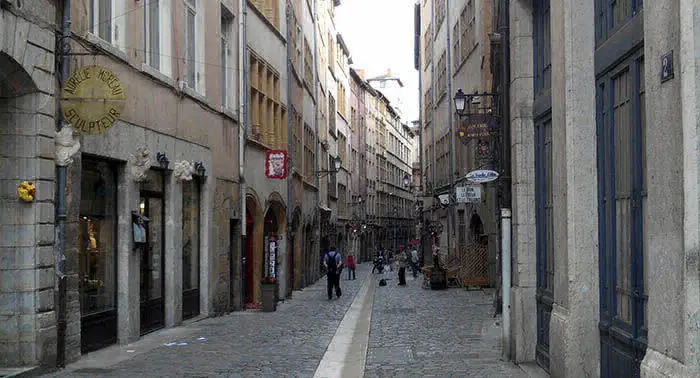
SAINT-JEAN DISTRICT
Next, we have the central Saint-Jean district, which was a neighborhood for the clergy and the aristocracy. These days, it’s the most touristic area of Lyon Old Town.
The lovely paved pedestrian street known as Rue Saint-Jean is the neighborhood’s main artery. Here, you can discover the city’s famous traboules; narrow passageways that wind through the many courtyards found around the zone. Be sure to visit The Long Traboule, which is famed for its picturesque pink tower. You can also observe many historical houses with ancient and magnificent architecture such as the Chamarier House, the Lyon Lawyers House, Laurencin House (which is also called the Grand Palace) and finally, Saint-Jean Square.
Don’t miss the Saint-Jean Cathedral, which was built between the 12th and 15th centuries in a mix of Romanesque and Gothic styles, and which is classified as a Historical Monument. Here, you can also visit the Gadagne museums using this audioguide.
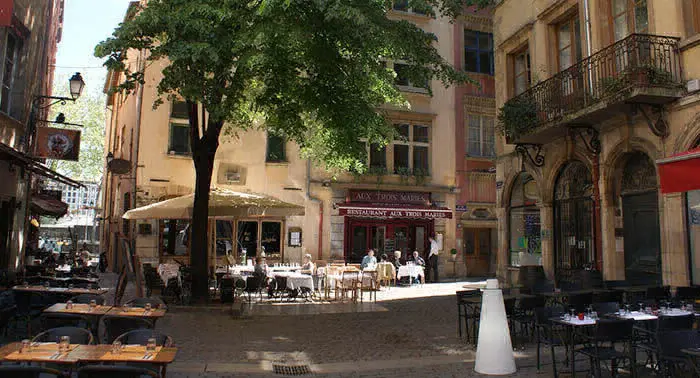
SAINT-GEORGES DISTRICT
Finally, the Saint-Georges neighborhood to the south was once the home of local artisans, and would later become the initial residence of the Canuts, before they moved to Croix-Rousse. This district has a number of exciting places to visit such as the Trinity Square that lies atop of Fourvière hill, Saint-Georges Church, and Guignol House, the most famous puppet in France created in Lyon at the beginning of the 19th century.
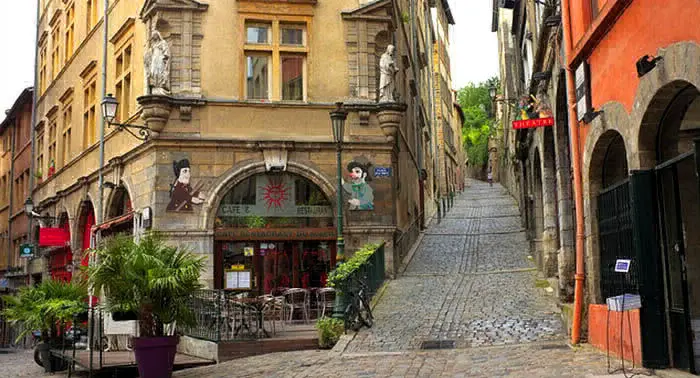
5) THE TRABOULES OF THE LYON OLD TOWN
A famous feature of Lyon, traboules are secret passages that cut through residential buildings to allow access to the other side. Several hundred traboules can be found in Lyon. Don’t miss the Long Traboule that connects 27 Rue du Bœuf to 54 Rue Saint-Jean. Another must-see is the traboule located at 16 Rue du Bœuf, which is one of the most beautiful and leads to a pleasant courtyard where you can admire the stunning pink tower and door of the Crible House. Some have stairs because they connect streets on a steep incline. The traboules of Lyon usually feature a light on the door that is illuminated at night when the exit on the other side is open.
Their origin remains a mystery. Some say the traboules were invented in the 19th century so that the silk workers, known as "Canuts," could quickly descend the slopes of the Croix-Rousse. However, construction of the traboules began back in the Middle Ages, long before the Canuts populated the city and wove silk in Lyon.
It could be that the traboules became a popular architectural feature of Lyon Old Town in the Middle Ages and the Renaissance. Perhaps they continued to be built because of their sheer practicality.
They played an essential role during the Canut Revolts, a series of worker uprisings that took place between 1831 and 1848. Resistance fighters also used the passageways during the Second World War.
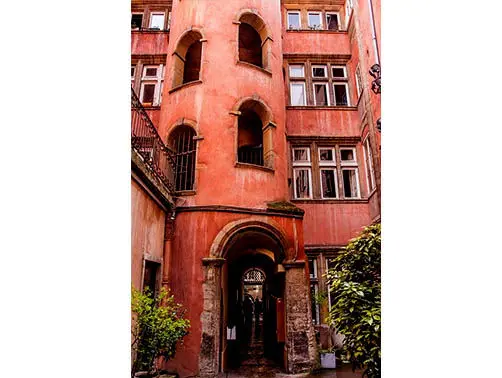
SAINT-JEAN CATHEDRAL
Located in the heart of Lyon Old Town, the Saint-Jean Cathedral was built between 1180 and 1480 and is one of the most beautiful religious buildings in the city. It is also known as the Primatial Saint-Jean because the city of Lyon was the Primate of Gaul, which means that Lyon housed the very first Christian church in France. Several significant events took place within its walls, such as the two councils of 1245 and 1274 , the coronation of Pope John XXII in 1316, and the mass held in honor of the royal marriage between Henry IV and Marie de Medici in 1600.
The cathedral is 80 meters long, 26 meters wide, and 32.5 meters high. In the interior, an absence of ambulatory architecture characterizes the churches of Lyon. Initially of a Romanesque style, construction lasted more than three hundred years and combined Romanesque with Gothic and even flamboyant Gothic, which attest to the extraordinarily long building process. You can see the chronology of its design inside: the western sections are distinctly Romanesque, and the closer we get to the facade, the more Gothic the style becomes.
The Cathedral houses a beautiful nine-meter high astronomical clock that’s worth examining in detail. It dates from the 14th century, and some say its original wrought iron mechanism is the oldest in France. The clock consists of a base of three spheres and a dome that houses the automatons, which include animals and a scene that represents the Annunciation. The statue on top of the astrolabe changes every evening at midnight. The spheres, the astrolabe, and the automatons of the primitive mechanism reveal themselves to the public every day.
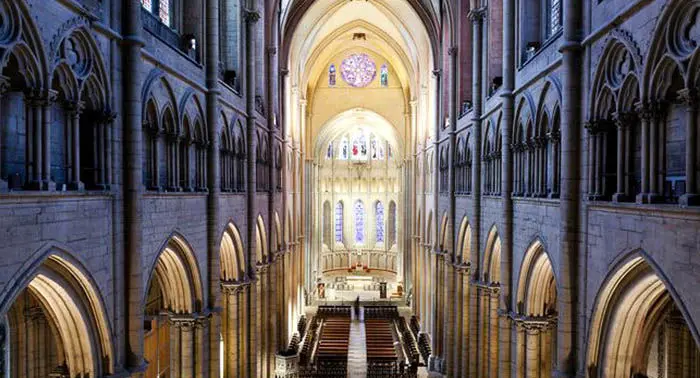
PLACE BELLECOUR
Located in the center of the peninsula, this is the go-to place for Lyon locals to hang out, especially at the foot of the equestrian statue of Louis XIV. The Bellecour is the most important plaza in Lyon and the fourth largest square in France at 310 by 200 meters, or some 62,000 m2. Its dimensions even exceed those of the Zocalo in Mexico City and the Red Square in Moscow. It’s also the largest pedestrian square in all of Europe.
The square lies in the second district of Lyon between the Rhone and the Saona. This plaza is where kilometer 0 resides, so all distances in the city get measured from this point. It’s also where the city’s altitude of 170 meters is counted from. From this square are the three main arteries of the peninsula, including two pedestrian thoroughfares: the Republic Street that leads to the City Hall and the Opera House, the Victor Hugo Street that leads to Perrache, and the President Édouard Herriot Street that leads to Place des Terreaux.
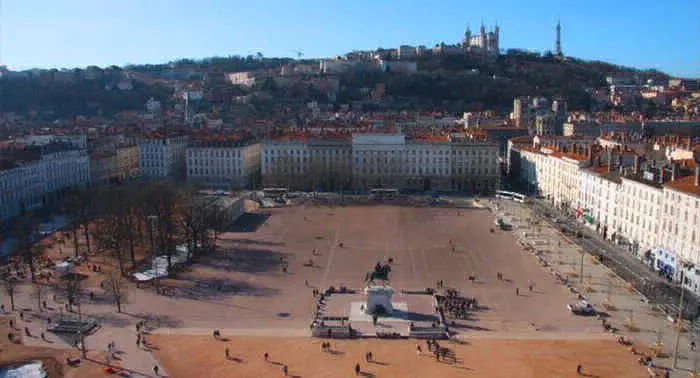
PLACE BELLECOUR (PART 2)
Within the square, we find an equestrian statue of Louis XIV accompanied by two 1720 allegorical statues created at its feet: the Saona by Nicolas Coustou and the Rhone by Guillaume Coustou. On the perimeter is the statue of the "Stone Watchman". Built by the architect Louis Thomas and sculptor Salendre, the figure stands where a bomb of the Lyon Resistance exploded on July 26, 1944. You can read the phrase: “Passer-by, go tell the world that they died in the name of freedom.” To the west is a statue of Saint Exupéry sitting in front of the Little Prince, which was erected in 2000 to commemorate the centenary of the birth of the famous Lyon native.
From Place Bellecour, you can easily reach Lyon Old Town on foot with the audio guide, or you can go shopping in the bustling retail streets that line the square. Don’t miss the antique shopping district, especially Street Auguste Comte and Street Charity, which are found on the way to Perrache station.
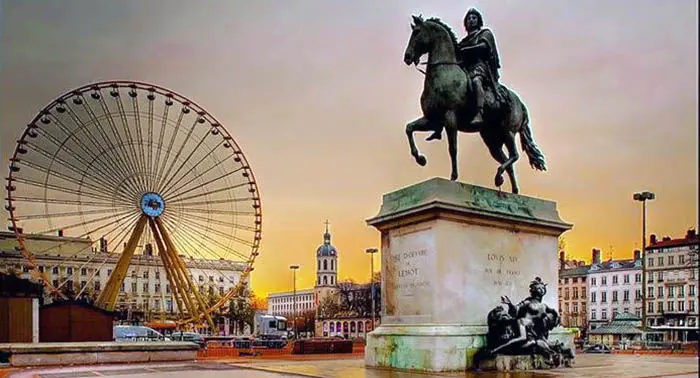
PLACE DES TERREAUX
Next stop on the audioguide is Place des Terreaux, which lies in the center of the Lyon Peninsula between the Rhône and the Saona, at the foot of the Croix-Rousse hill. Built around 1625 within the old trenches of a fortification, the 7,000 m2 plaza once served as an execution space for the inmates of the capital, as well as a market to sell pigs. The name "terreaux" means “mud” in English, which comes from the fact that muddy ditches comprised the space during Roman times. The plaza was paved and became a public square in the 17th century.
Considered by the Lyonnais as the most beautiful square in Lyon, its heritage is of utmost importance to the city. The first thing you’ll notice is its majestic fountain, the work of sculptor Bartholdi to whom we owe the Statue of Liberty in New York. Next is the Town Hall Building, a magnificent edifice where the government office of the first district resides. And finally, the Palais Saint Pierre, which houses the Museum of Fine Arts of Lyon. In the center of this building, the inner courtyard features a leafy garden with several sculptures. Entry is free from the entrance of the museum. You’ll be pleasantly surprised by the calm that envelopes the space despite all the commotion outside.
The square was renovated by the architects Christian Drevet and Daniel Buren in 1992, who moved the Bartholdi fountain and added another 69 fountains, each with a plush black granite basin.
Near the Place des Terreaux, you can visit the Place Louis Pradel with the audioguide to admire the back of the City Hall and the Lyon Opera.
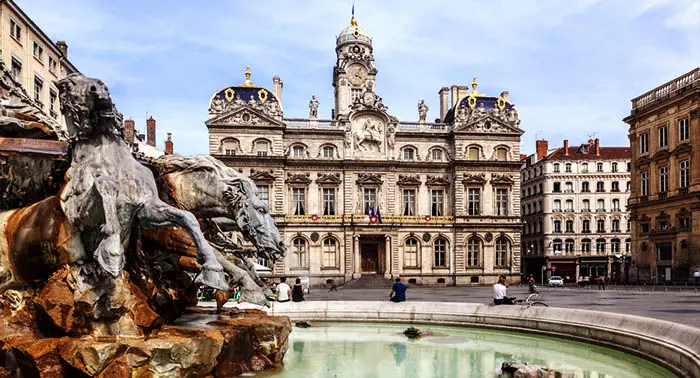
VISIT THE CROIX ROUSSE DISTRICT
Located atop a panoramic hill, the Croix-Rousse district will delight art lovers as it’s packed full of cute little artisanal handicraft stores. It’s accessible from the neighborhood of Terreaux by climbing up the hill. The Croix-Rousse slopes will take you to the Croix-Rousse plateau with its famous Gros Caillou, an enormous white rock that glaciers likely brought here from the Alps many millennia ago.
Don’t miss the Canuts House, which goes through the history of the silk industry in Lyon. Next, take a walk with the audioguide through the Amphitheatre of the Three Gauls, a Gallo-Roman site located near the Botanical Garden. Finally, at the foot of the hill between Rouville Square and Rivet Street, you can admire the strange Brunet House, also known as the “House of 365 Windows.”
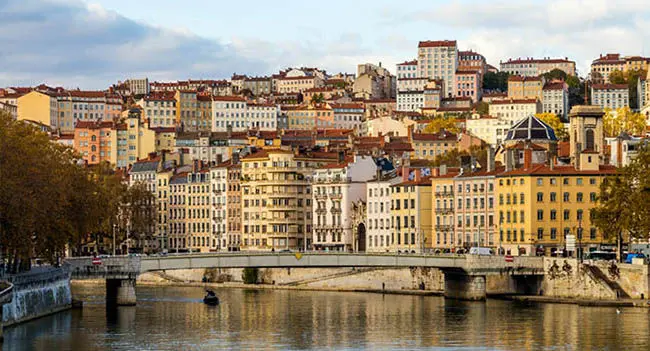
THE NOTRE DAME DE FOURVIÈRE BASILICA
This basilica, which features in the audio guide, is one of the most recognizable monuments of the city and one of the greatest symbols of Lyon. It is also the most visited site in town, attracting over 2 million visitors each year. Active travelers can access it on foot from Lyon Old Town by climbing up Chazeaux and its 228 steps, and then passing through the lush Rosary Garden. You could also take the funicular from Saint-Jean.
This neo-Byzantine religious building is the work of architect Pierre Bossan. The basilica complex includes not only the church and Saint Thomas Chapel, but also the panoramic esplanade, the Rosary Garden, and the Archdiocese of Lyon.
The most striking features of the Fourvière Basilica are the four 48-meter towers on each corner, which become somewhat bell-shaped as they ascend towards the top. Pierre Bossan was responsible for this architectural conquest, which has been widely praised by his contemporaries. Each tower bears the name of one of the four cardinal virtues. On the western facade, the northwest tower represents Fortitude, and the southwest tower represents Justice; while on the eastern side that faces Lyon, the north tower represents Prudence, and the south tower is for Temperance.
A statue of Saint Michael crowns the apse, which was sculpted by the workshop of Gayet-Gauthier; the same studio that forged the Statue of Liberty. In the iconography envisioned by Bossan, Saint Michael dominated the other archangels for their role in the struggle between Good and Evil. An exact replica of this statue resides in the bell tower of the Saint-Michel-Mont-Mercure Church in Vendée.
Don’t forget to admire the magnificent view from the Esplanade and walk around the region while accompanied by the audioguide, being sure to venture towards the Uplands Park and the Four Winds walkway.
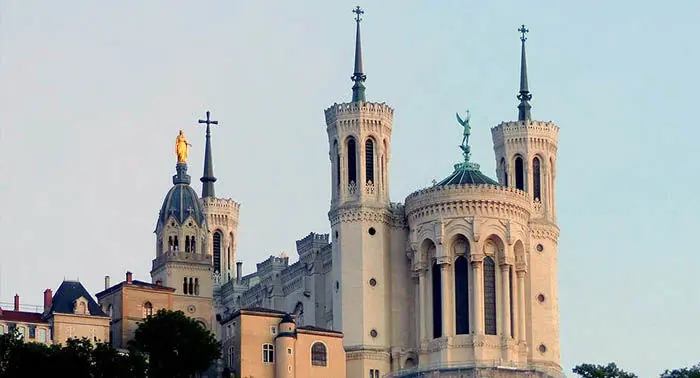
THE GALLO-ROMAN SITE OF FOURVIÈRE
The Fourvière theater is an ancient archaeological site that houses the remains of a Roman theater. Every summer, a popular music festival takes place known as the Fourvière Nights.
The theater was built on the slope of the Fourvière hill overlooking the city in the 1st century BC under the reign of Emperor Augustus. At that time, it was 90 meters in diameter. Some of the stones used in its construction were imported from Glanum, a faraway city that lay in the present day Bouches-du-Rhone region.
Emperor Hadrian expanded the theater at the beginning of the 2nd century, adding additional grandstands at the top of the hill. At that time, the building could accommodate up to 10,000 spectators. The space hosting countless musical performances, for which the theater was specially adapted: the stands were arranged to allow sound to reflect towards the audience.
After being abandoned at the end of the Roman Empire, it transformed into a quarry which became severely damaged and eventually buried sometime during the Middle Ages. It was later discovered by chance at the end of the 19th century, and then completely cleared out and painstakingly restored in 1933. Together with the old Odeon, the pseudo-sanctuary of Cibeles, and the Galo-Roman museum, the Fourvière Theater forms a remarkable archaeological site that is indicative of ancient Lyon.
The Gallo-Roman Museum of Lyon-Fourvière traces the origin of Lugdunum, and you can visit it with the audioguide as part of this archaeological site.
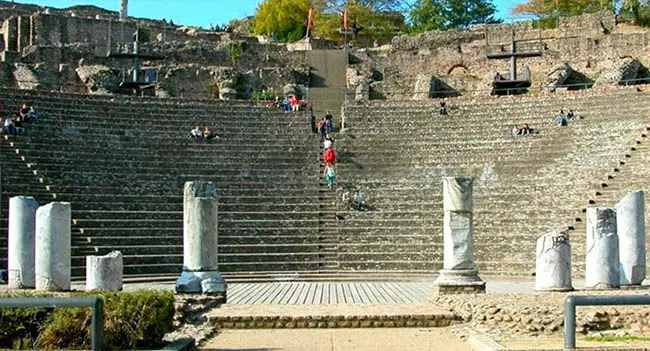
THE FRESCO OF THE LYONNAIS
The city of Lyon is full of fantastic painted facades. Of the 30 or so out there, the Fresco of the Lyonnais is especially worthy of a visit. Within this 800 m² fresco are representations of 30 historical figures who have defined Lyon, including the famous chef Paul Bocuse who was considered the Pope of French cuisine. The bottom section is painted in a trompe l'oeil style with impressive results.
To admire the Fresco of the Lyonnais, go with the audioguide to the 1st district, at the corner of 49 Quai Saint-Vincent and 2 Rue de la Martinière.
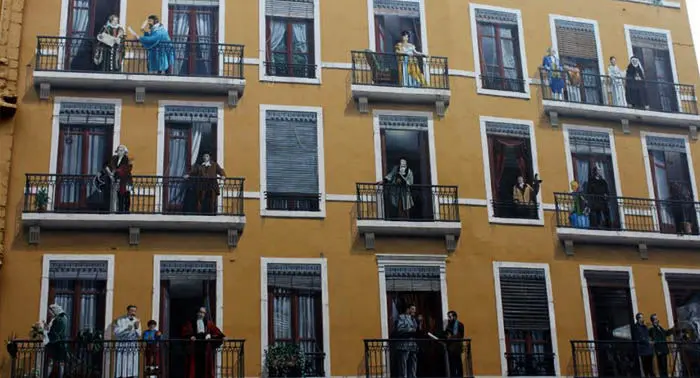
WALK ALONG THE BANKS OF THE RHÔNE AND SAONA RIVERS
The Rhone and Saona riverbanks both offer beautiful walks that deserve mention in this audioguide.
Starting from the Park of Gerland in South Lyon on the shores of the Rhone, you can walk along the river to the Park of the Golden Head and admire the Hôtel-Dieu, one of the oldest buildings in the city. Along the Saona, you’ll enjoy a splendid view of the Fourvière hill and the Lyon Old Town.
It’s also possible to observe Lyon on a river cruise to discover the city of lights from another angle.
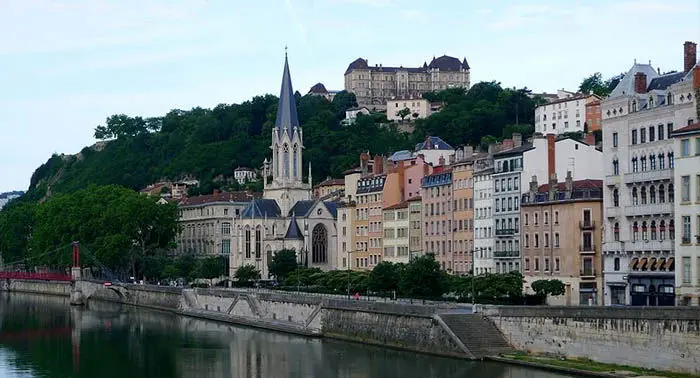
- Language English
- mp3 format
- Language Spanish
- mp3 format
PARK OF THE GOLDEN HEAD
Located in north Lyon within the elegant sixth district, the Park of the Golden Head is undoubtedly one of the most beautiful urban parks in France, not to mention one of the largest. With its 105 hectares of lush vegetation that surround a shimmering lake, it is the favorite park of the people of Lyon. Locals love coming here to jog or enjoy a stroll with their family. The park offers a multitude of fun activities and games for children as well. It’s a real pleasure to rent a boat and relax on the water.
For nature lovers, the park boasts several greenhouses with a rich collection of tropical and carnivorous plants as well as colorful orchids. Allow the audio guide to accompany you between the rose gardens that house several hundred varieties of this lovely scented flower.
Finally, children will love the park’s free zoo where they can observe numerous protected species. The Park of the Golden Head Zoo houses more than 400 animals: giraffes, panthers, Asian elephants, lions, Nile crocodiles, spectacled bears, and more!
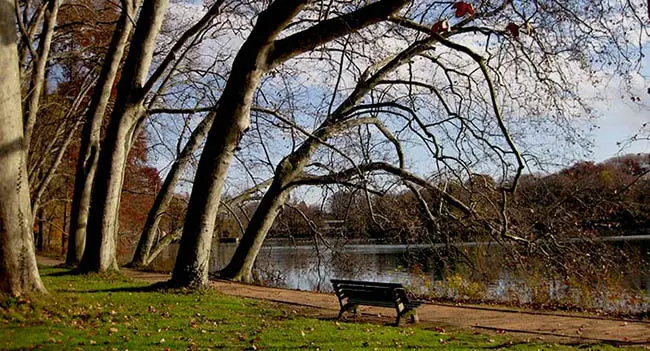
PARK OF GERLAND
Located in the 7th district in South Lyon, the Park of Gerland is the second largest park in Lyon after the Park of the Golden Head. Get here from Berges Park on the banks of the Rhone to appreciate this lush green space that serves as a popular meeting and leisure point for the people of Lyon. Don’t miss the Megaforbiaie, a botanical garden for aquatic plants.
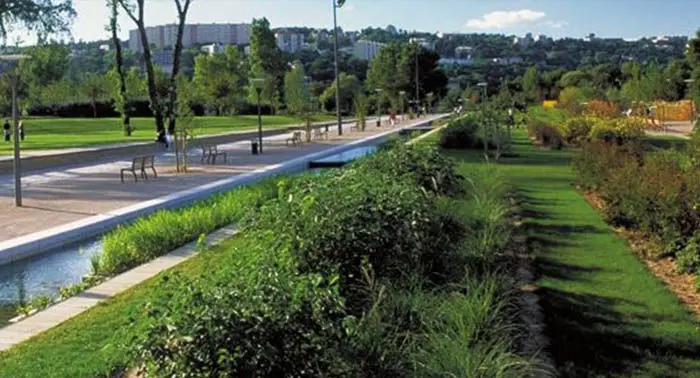
BARBE ISLAND
Located in the 9th district within Saint-Rambert-l'Île-Barbe, this green islet in the middle of the Saona River houses a beautiful Romanesque church, as well as the remains of an old abbey founded here in the 5th century. It was the first monastic settlement in the Lyon region and one of the oldest in all of Gaul. King Charlemagne bestowed it with a beautiful library. The monastery, which has been plundered several times (in 676, 725, and 945), fell under the rule of Saint Benedict in the 9th century and gradually increased in power before protestant troops burned it to the ground in 1562.
In 1827, a suspension bridge was built on the island at its southern end to link it with the right and left banks of the Saona, the villages of Saint-Rambert (today the 9th district of Lyon), and Caluire-et-Cuire.
A place packed full of intriguing Lyon legends, Barbe island welcomes curious passers-by, just as it welcomed the druids and the Christians back in its day.
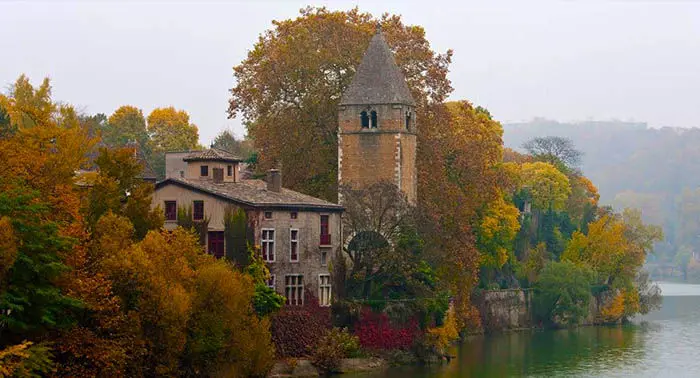
THE FESTIVAL OF LIGHTS
The Festival of Lights attracts around 4 million visitors to Lyon each year. The event, which is celebrated on December 8 and lasts 3 to 4 days, is an opportunity to admire Lyon’s most beautiful monuments as they’re lit up in a captivating display.
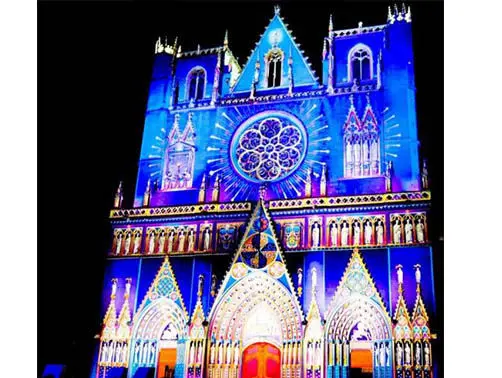
EAT IN AN AUTHENTIC LYONNAIS BOUCHON
As the French capital of gastronomy, Lyon is the ideal city for a culinary vacation. The city’s famous restaurants offer quality local cuisine that is rich in flavor and come at a modest price.
Mostly cluttered together in the Lyon Old Town, the traditional Lyon restaurants known as Bouchons are a gastronomic institution. It’s also worth discovering the best ice cream parlors in Lyon.
Some of the city’s culinary specialties recommended in this audioguide include:
- La Cervelle de Canut (Canut's Brain): Contrary to the name, this dish doesn’t contain any brains, but rather freshly beaten cheese and cream with finely chopped shallots, chives, and parsley. The impoverished Canuts used to eat this simple dish to fill up after a long night’s work.
- Quenelle: a dough made of flour, egg, and fish in the form of croquette. The quenelle is boiled in water before being cooked and served au gratin with delicious Nantua sauce.
- Andouillette, A.K.A French sausage: one of the many dishes made with giblets and tripe that is typical of Lyon. The beef or pork sausage is served hot with white wine, either battered or au gratin.
- Sapper's Apron: Also belongs to the tripe and giblets family, and is somewhat similar to a breadcrumbed scallop. The dish is pan-fried and served hot with a tangy mustard-based gribiche sauce. The name Sapper's Apron comes from the cowhide aprons which were designed for the hard-working sappers that served Napoleon III.
- Tête de veau: if you’re feeling brave, try the Lyon style poached calf’s head that comes with gribiche or ravigote sauce and a side of steamed vegetables.
- Sabodet: Sabodet is a sausage made from chopped up pigs head, which is cooked in water and served in slices alongside steamed vegetables, mustard, and pickles.
- Poularde: this traditional dish is served in many Lyon restaurants, including its most renowned gastronomic establishments. Pieces of truffle are inserted under the skin of the hen before it’s stewed. The chicken takes on the subtle flavor of this prestigious mushroom and served with vegetables that have been slow cooked in their juices. This dish is particularly welcoming for all those who aren’t too fond of guts and brains.
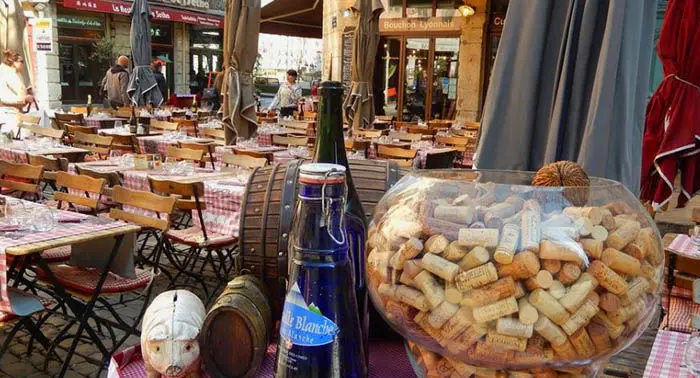
Audio guide devices, Multimedia audio guides,
Audio guide GPS tourist bus-train, charging bases and accessories.
Group guidance systems, headsets, charging cases, tour guide systems accessories.
Audioguides available from mobile devices, web App, downloadable App from Google Store.
Audioguides in several languages, translations, voiceovers. Audio descriptions, signoguides, visual contents for audioguides. 3D Reality.